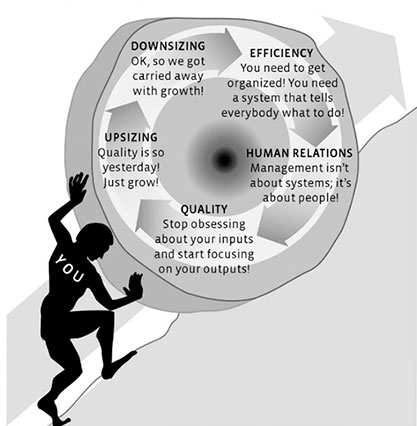“Joseph Beuys Titles for Sculptures,” in David Levi Strauss, Between Dog & Wolf: Essays on Art and Politics in the Twilight of the Millennium (Brooklyn: Autonomedia, 1999), 141.
Matthew Stewart, The Management Myth: Why the Experts Keep Getting it Wrong (New York: W.W. Norton, 2009).
Matthew Stewart, “The Management Myth,” The Atlantic, June 2006 →
Far from becoming obsolete or collapsing, management consultancy is diversifying and buying itself up. For example, longstanding management firms (McKinsey and the like) are supplementing their services by hiring entire creative groups as their own in-house consultants. Interview with Thomas Ulrik Madsen, May 16, 2016.
Claire Bishop, Artificial Hells: Participatory Art and the Politics of Spectatorship (Brooklyn: Verso, 2012), 177.
Until the mid-1970s APG worked primarily with private companies but eventually shifted towards working with governmental organizations, reportedly because long-term contracts with corporations were hard to obtain. It is notable that APG was initially formed as a charity and only later incorporated into a limited company and eventually a multinational corporation. The shift to Ltd. status was partially due to the fact that it allowed artists to be paid a salary on par with other professionals.
John Latham, “The Incidental Person Approach to Government,” presentation at Joseph Beuys’s Free International University, documenta 6, Kassel, 1977.
As quoted in John Walker, John Latham: The Incidental Person—His Art and Ideas (London: Middlesex University Press: 1994), 100.
John Latham, “Artist: John Latham Placement: Scottish Office (Edinburgh),” Studio International, March–April 1976: 169–70.
Full quote: “It is also important to maintain and enhance in this country a pluralistic approach to our social needs, or the government will inevitably be brought in to address problems if other initiatives are not forthcoming. It isn’t enough to decry the expansion of governmental activity into every nook and cranny of public and private life. Surely the business community with its enormous intellectual, financial, and other resources can develop alternatives in the area of social problem-solving.” Frank Koch, The New Corporate Philanthropy: How Society and Business Can Profit (New York: Springer, 1979), 4.
Kelsey Campbell-Dollaghan, “How Startup Culture is Transforming Philanthropy,” Fast Company, April 11, 2013 →
I’m focusing on artists engaged in the private sector, though plenty work for governments and philanthropic organizations.
The definition of “ambiguity” from a dictionary written in 1973 by the members of the Art & Language group. Art & Language, “15: Ambiguity,” Blurting in A&L Online (Karlsruhe: ZKM, 2002) →. (Thanks to Carson Salter for unearthing this.)
In particular, “speculative design” increasingly provides a midway point between art and industry. According to California-based artist, designer, curator, and technologist Barry Threw, “More tech companies will be able to understand speculative design as a way to incorporate lateral and theoretical thinking, and this will open up a new role for artists.” Interview with author, May 24, 2016.
Carson Salter, Ambi_ Enterprise artworks, the artist-consultant, and contemporary attitudes of ambivalence, Master of Science at the Massachusetts Institute of Technology, June 2013, 68.
Walker, John Latham, 100-101.
